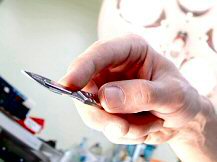 With the recent thumbs-up by the World Health Organization of adult male circumcision as a strategy for HIV prevention, there is a new sense of urgency - particularly in regard to Africa - to develop safe and cost-effective circumcision services. To this end, physicians at the Weill Cornell Medical Center are evaluating an innovative circumcision device developed in China.
With the recent thumbs-up by the World Health Organization of adult male circumcision as a strategy for HIV prevention, there is a new sense of urgency - particularly in regard to Africa - to develop safe and cost-effective circumcision services. To this end, physicians at the Weill Cornell Medical Center are evaluating an innovative circumcision device developed in China.
The device, named the ShangRing (after its inventor, Mr. Jian-Zhong Shang), consists of two concentric plastic rings that sandwich the foreskin, allowing it to be cut away without suturing and with minimal bleeding. Performed in a clinic under local anesthesia, the procedure takes less than five minutes, compared with approximately 20 to 30 minutes for a traditional circumcision that requires suturing. The patient returns after one week for device removal.
"Circumcision with this technique promises to be faster, safer and more acceptable to patients than conventional surgical circumcision methods," says Weill's Dr. Marc Goldstein, who will initiate a study of the device in Africa in the coming months.
The ShangRing has been used to circumcise several thousand Chinese men since 2005. Preliminary reports indicate good results with minimal complications. The ShangRing is currently available only in China although FDA evaluation is under way.
"The beauty of this device is its simple, innovative design," says co-researcher Dr. Howard Kim. "Although many male circumcision devices are available, they have not gained widespread acceptance due to high complication rates or difficulties with surgical technique."
"Even non-physician health care providers will be able to learn this procedure to safely perform circumcisions in resource-poor regions," adds Dr. Richard Lee, a chief resident in urology at Weill Cornell Medical Center and another member of the research team.
Related:
Mass Circumcisions In Africa "Could Prevent Millions Of AIDS Deaths"
The Case For Penis Pruning
HIV And Circumcision
The American Penis: In Circumcision We Trust
Foreskin Appears To Harbor HIV
Source: Weill Cornell Medical College

